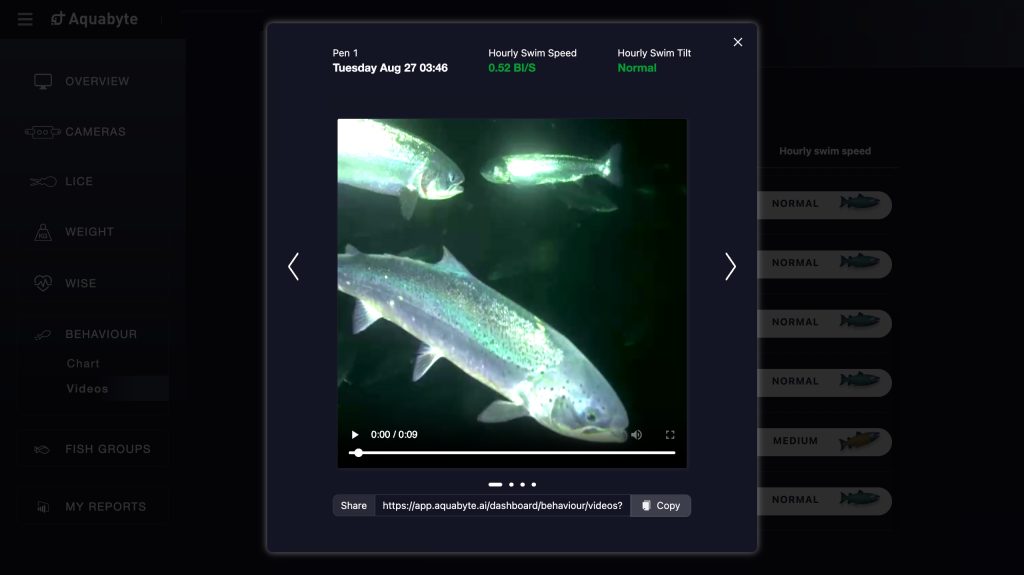
More effective measures with early warnings and insights into fish behavior
Our BEHAVIOUR product monitors fish behaviour-related welfare. By measuring swim speed and swim tilt, BEHAVIOUR provides valuable insights into the conditions within the pen and can alert of changes in the fish’s overall welfare and stress levels. Speed and tilt are continuously monitored, with data updated hourly in the Aquabyte User Portal. BEHAVIOUR also automatically stores video clips from the pen, which can be shared with colleagues.
Benefits of using Aquabyte BEHAVIOUR
- Simplified monitoring and recording of swim speed in submerged production
- Early warnings of changes in fish stress levels
- Early warnings of conditions that may lead to reduced growth, welfare challenges, and, over time, increased mortality
- Access to video clips of fish with abnormal swim speed or swim tilt.
Implement measures earlier
Changes in fish behaviour can be early signs that something is happening in the pen. Such changes are often difficult to detect through standard observations from the pen edge. In closed or submerged production environments, the risk of behavioural changes being overlooked – whether caused by biological challenges or external factors – is significantly increased.
Aquabyte BEHAVIOUR monitors fish swim speed and swim tilt, providing updated data every hour. This enables early warnings of potential challenges, allowing for faster and more precise actions to prevent reduced fish welfare and increased mortality.

Swim speed
In BEHAVIOUR, swim speed data is presented both as daily averages and in graph form. Speed is measured in body lengths per second (BL/s), with abnormally high swim speeds highlighted using color codes, making it easier to detect and respond to critical changes.
The graphs make it easy to observe changes in swimming speed, which may be caused by elevated stress levels or welfare-related challenges. Changes in swim speed can also reveal shifts in biological or environmental factors that affect fish behaviour and welfare. Examples include jellyfish attacks, the presence of foreign fish, increased algae levels, or endringer in oxygen levels.
In submerged pens, where swim speed data needs to be documented, BEHAVIOUR will replace time-consuming and inaccurate manual measurements.

Swim tilt
Swim tilt monitors the fish’s horizontal tilt (the position and angle of the head relative to the direction of movement) while swimming. High tilt, where the fish’s head is consistently higher than the rest of its body, may indicate an inability to maintain proper buoyancy. A common cause of such behaviour is insufficient access to air, preventing the fish from refilling its swim bladder.
In open surface pens, refilling the swim bladder is usually not a challenge, as salmon can surface to do so. However, in submerged pens where salmon must obtain air from a dome, a sudden increase in tilt may indicate critical issues with air supply. The consequences of this can include reduced growth, welfare challenges, and, over time, an increased risk of mortality. In BEHAVIOUR, data on both swim speed and tilt is updated hourly, enabling early warnings if something is amiss.

Automatically stores video snippets
BEHAVIOUR automatically stores four short video clips from each hour during data collection. These videos, available in the Aquabyte User Portal, can be used to verify changes and deviations in fish swim speed or tilt. The system archives clips from the past 30 days, allowing them to also document the effects of changes in water quality, welfare, and other critical parameters over time.
Through BEHAVIOUR, all stored videos can easily be shared with colleagues who have access to the Aquabyte User Portal.


